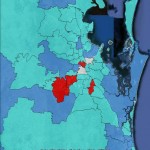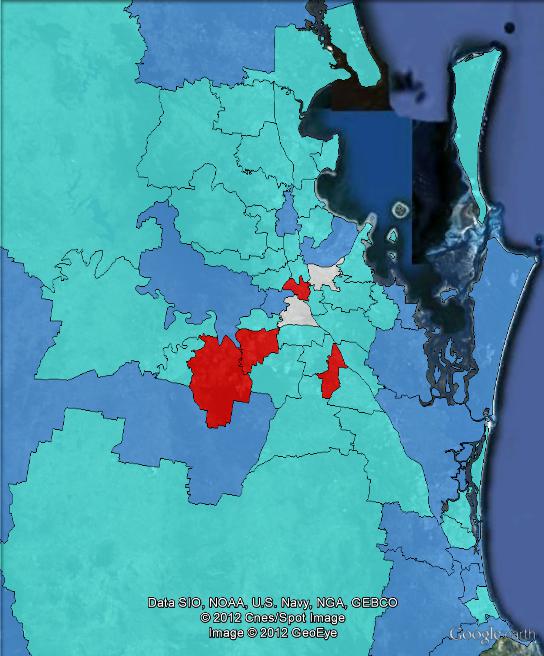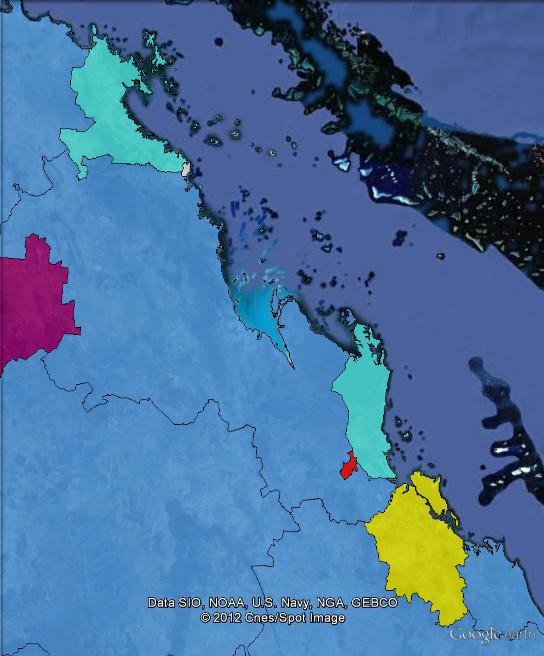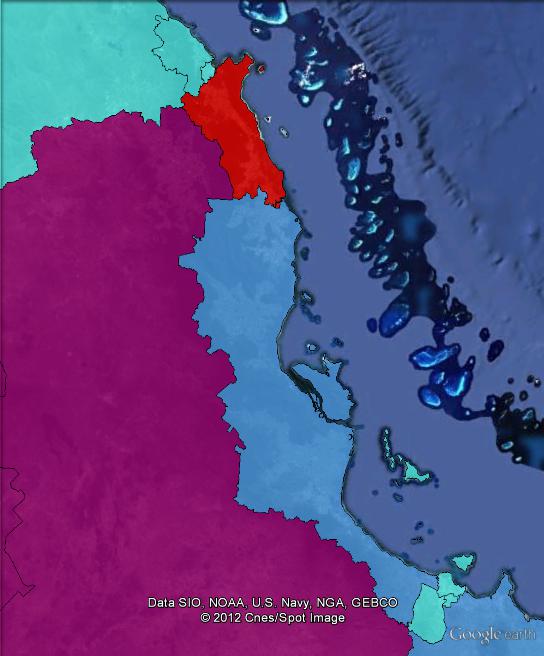 As of this morning, the result is Liberal National Party on 76 seats, the Labor Party on 6, Katter’s Australian Party on 2, and two independents. This leaves three seats too close to call: Bulimba, Mackay and Yeerongpilly. At the moment the ALP is ahead in Bulimba and Mackay and the LNP is ahead in Yeerongpilly.
As of this morning, the result is Liberal National Party on 76 seats, the Labor Party on 6, Katter’s Australian Party on 2, and two independents. This leaves three seats too close to call: Bulimba, Mackay and Yeerongpilly. At the moment the ALP is ahead in Bulimba and Mackay and the LNP is ahead in Yeerongpilly.
Considering the scale of the Liberal National success, I’m going to focus instead on the other parties. Needless to say, the Liberal National Party gained seats everywhere. They gained Labor seats on the Gold Coast and throughout Far North Queensland. They knocked off the last Labor seat on the Sunshine Coast and 1-2 of Labor’s three remaining seats in Central Queensland. Meanwhile they well and truly dominated the Brisbane area. Before the election the LNP held only six seats in the greater Brisbane area: now Labor only holds 4-5.
The LNP also managed to regain the seats of Burnett and Beaudesert off defectors Rob Messenger and Aidan McLindon, and regained the seats of Nanango and Maryborough off other independents.
Labor now holds 6-9 seats after the election. These seats are:
- Bundamba – Ipswich suburbs, 21.2% margin.
- Inala – Brisbane suburbs, 21.5% margin.
- Mulgrave – Cairns suburbs, 8.1% margin.
- Rockhampton – Central Queensland, 17.9% margin.
- South Brisbane – Inner Brisbane, 15.0% margin.
- Woodridge – Logan, 25.4% margin.
And they might also win:
- Bulimba – Inner Brisbane, 7.8% margin.
- Mackay – Central Queensland, 16.7% margin.
- Yeerongpilly – Brisbane suburbs, 8.7% margin.
If you look at these seats on the pendulum, it is a clear result. Bundamba, Inala, Rockhampton and Woodridge are the party’s four safest seats, with margins over 17%. The next two most marginal are Ipswich and Mackay. Mackay is currently undecided, and Ipswich was lost with a massive 20.8% swing, as predicted by commenters on this blog. South Brisbane is not much further down the pendulum. After South Brisbane you pass another ten seats before you reach Yeerongpilly, Bulimba and Mulgrave, which all had margins of 7-9%. Curtis Pitt’s survival in Mulgrave is largely due to a massive vote for Katter’s Australian Party undermining the LNP swing, while in Bulimba and Yeerongpilly the Labor MPs managed to keep the swings to lower levels from which they have a chance of survival.
Labor’s defeats put them in a severely weakened position. They now hold no seats north of the Brisbane, all the way until you get to Mackay and Rockhampton. They also hold no seats on the Gold Coast, Sunshine Coast or in Townsville. In the area of Brisbane south of the river, Ipswich and Logan, the party has been reduced to 4-6 seats, compared to 19 before the election.
In addition, the party holds 1-2 seats in Central Queensland and only one in North Queensland. In 2009 Labor won all three seats in Townsville, as well as all four covering Cairns, and Mount Isa. Out of these eight, Labor has held on to one, losing six to the LNP and one to Katter’s party.
Katter’s Australian Party performed strongly for a minor party, holding on to two seats and playing a large role elsewhere. The party focused on two elements: campaigning on coal-seam gas in rural parts of Southern Queensland, and campaigning on Bob Katter’s name in the far north. Poll Bludger’s regional breakdown of results shows that the party was far more successful in the north. The party averaged over 20% across the far north, the interior and the north coast, as well as winning two seats. While the party did well in seats like Nanango and Beaudesert, it wasn’t enough to pry them away from the LNP. Overall the KAP came in the top two in twelve seats.
The Greens saw their total statewide vote go backwards, from 8.4% to 7.6%. In the Greens’ key seat of Mount Coot-tha, the Greens went back 3%, with the sitting Labor MP Andrew Fraser going back by 8%. The Greens managed to come second in Indooroopilly, where the Greens and Labor went back by a total of 15%, leaving the sitting Liberal National MP with over 61% of the primary vote. I could only find one other seat where the Greens came in the top two, with the party winning 17% in Noosa, which put them ahead of Labor and the KAP. Looking at the breakdown, the Greens went backwards in every part of Queensland except on the Sunshine Coast.
I’ve now uploaded the updated version of the 2009-2012 map for Google Earth, with the seats coloured as of the latest results. You can also download a time-series map which allows you to flick between the results of the 2001, 2004, 2006, 2009 and 2012 elections.






Great analysis Ben. Thanks. Do you think the csg strategy failed to yield for KAP in south, or that it just wasn’t as successful as their campaign in north? Did it play well for the greens?
The Katter Party seems to have done quite well. Not as well as some of the hype but still quite well for a beat the ALP with the LNP stick election. They are in a good position to pick up votes and seats at the next election. Particularly with a Brisbane based LNP leader.
Ben,
Obviously your old uncle is delighted with the Qld result having spent several demoralising election days working booths and scrutineering in the Ashgrove electorate in the late 80s. However, we should all be wary of the size of the KAP vote in this election. The KAP might have (officially) campaigned on coal-seam gas and Bob Katter’s ‘fame’ but the reality is that they stood for bigotry and intolerance and that is what attracted the ‘hayseeds’ who voted for them.
@Sam
I don’t think it failed, but Katter’s pull was stronger in the north, and CSG wasn’t enough to win any seats.
@Peter
I totally agree. Many on the left have tried to look at the good bits of Katter (anti-privatisation, anti-CSG, quite good on indigenous issues) and see him as a good thing for the left, but ultimately they are clearly culturally part of the right, and are carrying the legacy of One Nation and the old Queensland Country Party.
My next blog post will go into the idea that it is very good for Australian politics to have a strong, credible right-wing minor party to balance out the Greens.
Interesting to see though that Greens picked up vote in 24 seats, mainly regional. Maybe just anomalies given that they were small moves or maybe that says something about local issues or candidates.
Interesting to note that the two Brisbane seats where Labor held the swing down best were Greenslopes and Bulimba, both where one K Rudd was heavily campaigning for the local MPs…….
I get a feeling this will not go unnoticed…
I can’t help thinking the current LNP majority will slip back a little once the declaration votes (pre-poll, postal, absentee, etc.) are in.
It’s astonishing enough that some seats Labor held on a margin of less than 10% look like staying with Labor. I wouldn’t be surprised if some seats rated gone at the moment end up staying. I’d also hold out on Maryborough and Nicklin – I imagine both Foley and Wellington might hang on after declaration votes.
I don’t think much more than 0.5% or so can be turned around on postal votes. Certainly we won’t see seats where the LNP leads 2-3% being lost on declarations.
I think that the small loss of the green vote, in an election with a massive pull to the right, was not too bad. I think it shows that the greens base vote in queensland is there to stay.
Comments are closed.